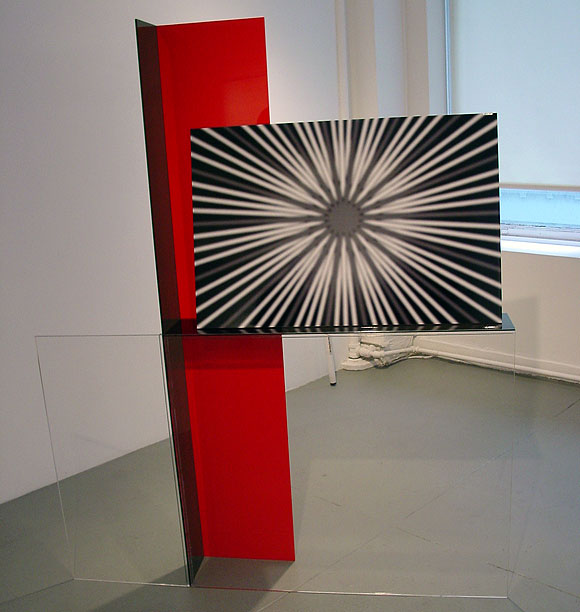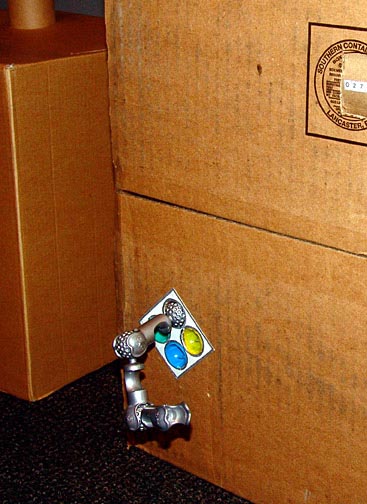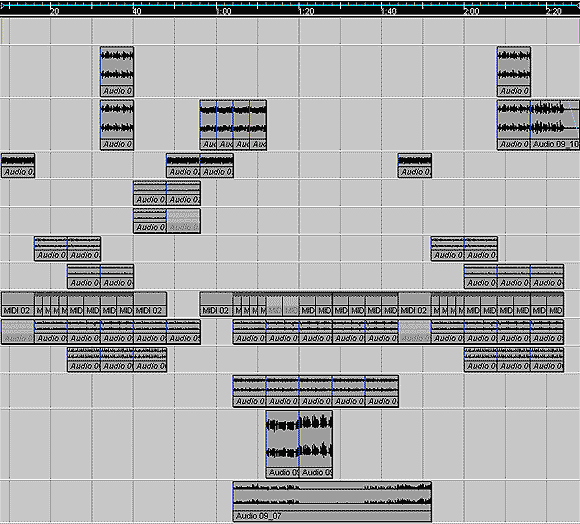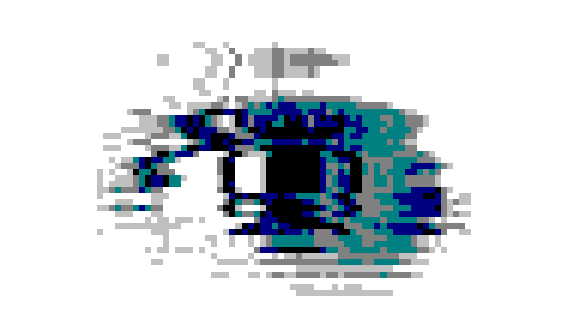View current page
...more recent posts

Art by Roy Stanfield, from a group show he organized at Moti Hasson gallery. The image is a copyright-free starburst pattern he scanned, fuzzed out in an imaging program, mounted on Plex, and perched on a ledge in this plexiglas structure. (The unfuzzed version is on the back.) Stanfield belongs to the proud tradition of what might be called "focused desultoriness" that includes Robert Rauschenberg and Rachel Harrison (but not so much Cady Noland, contrary to some earlier speculation--the work isn't as dark). His twist on those artists is the knowing and unpretentious use of digital technology and the Web in his content.
In August I did a post about the interesting cross-disciplinary issues that come up when critical-minded folks from the club music scene describe academic electronic music with their own carefully honed vocabularies and sensibilities. Another good example comes, of course, from electronic dance/post-punk specialist Simon Reynolds, in this respectfully irreverent paragraph I just found on his blog:
Along with its relative affordability, one of the things I like about the second-division electronic avant-classical is its generic-ness. I mean that most sincerely folks. There's two facets to this 1/ if it’s a genre you love (say, ardkore, or freakbeat/garage punk, or dub, or whatever) then the genre-icity is no problemo, in fact the more fiercely it is itself, rather than dabbling outside its own parameters, than the better really; plus you have such an appetite for the stuff in question that you crave the second or even third-division material. But also 2/ there's this extra element of pathos and even a tiny hint of comedy too. See, here’s these guys who thought they were opening up infinite vistas and spectra of sound, boldly going where no composer's gone, building the future, etc. Yet a lot of it does tend to sound a bit samey. Partly because they only had a few different instruments at this point to grapple with: the Buchla, the Moog, a few other machines. But also beca[us]e a certain lexicon of sounds and FX got established that people tended to go for. In fact if I have some time at some point I’d like to do a taxonomy of those 12 or 16 or 23 noises/devices/effects, 'cos they do tend to crop up rather frequently. The other reason the avant-electronic stuff can sound generic is that the composers tended to use the machines as tools for extending their pre-electronic ideas, rather than search for the absolute idiomatic thing the machine could do. So there’s a lot of post-serialist approaches being transposed to synthesiser, I reckon. Which is why you get that feeling of clutter and twitter, flurries of note-runs and clusters, a fidgety fraugh[t]ness. There's also that atmosphere of disquiet that's very post-War existen[t]ialist-modernist-neurotic, kinda highly-strung and almost hands-wringingly anguished at times. But I suppose this makes perfect sense, was inevitable: composers who studied theory and went through conservatory training and all that, who have followed the grand narrative of western musical thought all the way through to the present juncture, or their own personal version of that arc/dialectic/whatever--they're not going to suddenly junk all their ideas and concepts and nous and technique, and just lay themselves open to the potentialities of the machinery, in a state of mind-voided open-ness and zero preconceptions. They’re going to dictate to the technology rather than the other way round. But that explains why a lot of the avant-electronic music sounds like 20th Century classical, as opposed to utterly alien and foreign, which you get more with your rock people perhaps, who lack the composerly grounding and also have more of a cheap thrills/gimmicky slanted approach to new tech.

Kristin Lucas, Happy and Sad Sack Lunch Series 2005. (Detail above.)
More from her archive.
"Sawtooth Junction" [mp3 removed]
This is kind of a happy song, incorporating folk, classical, and techno-rave influences into a single perky package. Within my tiny little corner of the home-producer sphere, I do have ambitions. I'm starting to get a method down of playing* and recording blocks of notes, using those blocks to write harmonically and timbrally compatible new blocks, then shuffling everything around with an eye to song development or at least some unfolding surprises. Each recorded block is a gestalt or hybrid of a particular type of (synthesized, filtered) sound with a particular sequence of notes. A block could be a melody or a rhythm. Obviously the design of the sequencer/recorder shapes and encourages this composition method, just as I'm sure a harpsichord and musical staff paper bred its own type of music. I know others put a lot of effort into making "natural"-sounding transitions between measures but I Iike a certain music box artificiality in the sound.
*By playing I mean writing notes, programming the synths and filters, and letting the sequencer play the sounds. I'm into "post-hand" music in a way I'm not with art, entirely, yet.
Updated with minor edits: reduced the volume on one of the hi-hat tracks; fixed a couple of glitches.

Matt Stoller of MyDD has been following the Connecticut senate race, as a Ned Lamont supporter, in the aftermath of the primary when Lamont whupped the odious Joe Lieberman. It's not looking too good--polls show Lieberman, now running as an indie, ahead. Stoller says this:
I've developed a keen respect for Senator Lieberman over the past few months. The man is completely brilliant, probably the best politician I've ever seen up close. When he wants something, he goes and gets it. He's not just a great politician, he's an extremely skilled sociopathic charmer, able to appeal to one's worst instincts while making you feel like he's helping create resolute moral tone. Lieberman is the consummate small state politician; he has the press here wrapped around his finger, and he is able to create an aura of trust and geniality wherever he goes, even as he calls for regime change in Iran and sends his voters' children to be maimed for his own pride. It's a stunning feat. So the challenge is great, and it's not supposed to be easy, because convincing the public that they have been voting for a psychotic man divorced from the consequences of his brutal actions is really tough when that creepy package is delivered in a Happy Meal.I believe Stoller is learning on the job that Holy Joe is a "consummate small state politician." The progressive narrative during the primary fight was that Lieberman had "gone Washington" and lost touch with his constituents.

In "How to Make a Power Grab Mundane," in Editor and Publisher, James Bovard nails the bland language the Washington Post used to describe the enactment of the Bush/McCain torture law:
The Military Commissions Act is widely seen as legalizing torture, but the article avoids any such mention of the T-word. Though the act revolutionizes American jurisprudence by permitting the use of tortured confessions in judicial proceedings, the Post discreetly notes only that defendants will face “restrictions on their ability to ... exclude evidence gained through witness coercion.”Court challenges to this horrible law will need to be robust and unceasing. Let's hope the civil rights bar is up to the job, since we obviously can't count on newspapers to protest the dismantling of Constitutional protections of freedom and individual rights.
The lead of the Post article declares that the new law will “set the rules for the trials of key al-Qaeda members.” A typical subway strap hanger reader might shrug at this point and shift to the Sports section to read the latest autopsy on the Washington Redskins. The Post neglects to mention that the bill codifies the president’s power to label anyone on Earth an “enemy combatant” -- based on secret evidence which the government need not disclose.
Almost let Brian De Palma's The Black Dahlia slip out of the threatres, noting the so-so reviews, and then remembered, with a forehead slap, he always get bad reviews--until 5, 10, 20 years later, then everyone loves his work.
It's awesome. Yeah, yeah, Josh Hartnett and Scarlett Johansson are wooden, so what? You don't go to this man's films for the acting--it's adequate. With De Palma it's the architecture, the slithery camera unhinged from narrative (or so we think until it reveals something important), the overwhelming sense of place, the visual clues and puns, the high camp melodrama, the intricately worked out geometry of every scene. The shot of the creepy slum houses under the "Hollywoodland" sign alone brings James Ellroy to life, but the "discovery of the body" scene takes his tawdry view of tinseltown to a whole other macabre level. The movie is shot on digital video but it feels big screen ambitious.
Go, go tomorrow. Be sure to look for Mia Kirshner as the Dahlia--she played "the babysitter" in Atom Egoyan's Exotica and seems forever on the verge of a major career. May she be another Jennifer Connelly blessed with a "late break." She's really good.
